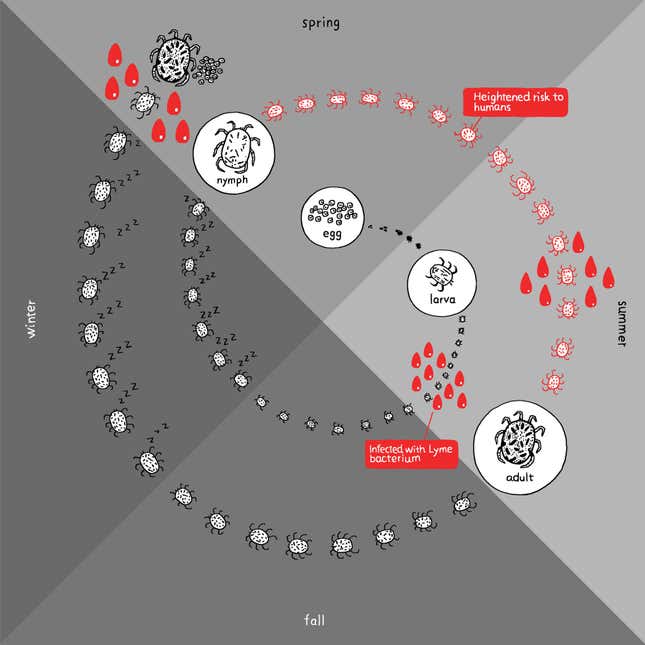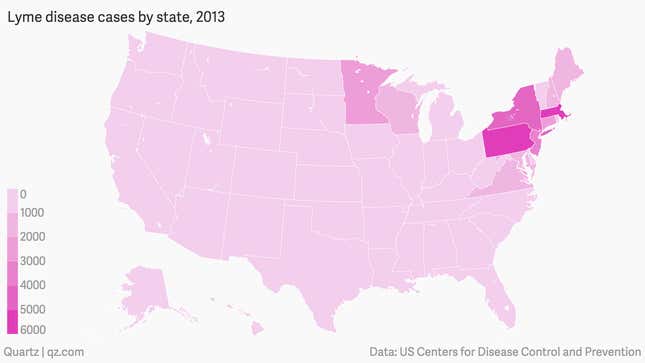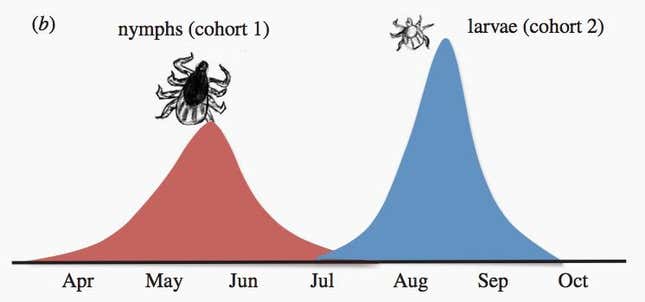Avril Lavigne is the latest celebrity to reveal being felled by Lyme disease. After months of withering fatigue, the Canadian singer-songwriter was finally diagnosed with the tick-borne illness and now expects a full recovery. Those who take longer to be diagnosed are often less fortunate. Best-selling author Amy Tan’s battle with Lyme left her with 16 brain lesions, epilepsy and, if she misses her course of antibiotics, the inability to recall what she just read. Punk icon Kathleen Hanna’s struggle with the disease all but ended her career.
They’re not the only ones. Around 10% of Americans say they know someone with long-term symptoms of Lyme. Each year, 300,000 US residents contract Lyme, estimates the US Centers for Disease Control (CDC). And given how inconsistently the condition is diagnosed and reported, it could be far more—as many as 3 million cases a year, says Keith Clay, professor of biology at Indiana University. The official number of new US cases—the only available proxy for overall cases—has been growing at double-digit rates:
A similar story is unfolding across the Atlantic. Though the World Health Organization records about 35,000 Lyme cases in Europe each year, other estimates put it at 65,000. Another 3,500 or so occur in Asia.
We’ve known about Lyme for many decades now. So why is it growing?
Two factors in particular seem to be making it easier for the tick that carries Lyme, the American blacklegged tick (Ixodes scapularis)—and in Europe, its cousin, the castor bean tick (I. ricinus)—to spread the disease. One is an explosion in the populations of the creatures on whose blood it likes to feed. The other is global warming. Both, of course, are humanity’s fault.
Questing for bloodmeals

Ticks feed entirely on blood. They need a bloodmeal to graduate from larva to nymph and from nymph to adult—the three stages of their life cycle. Females must take a third bloodmeal to lay eggs. All this usually happens in about the space of two years.
When they hatch (usually) in late spring, tick larvae are tiny—no bigger than the period at the end of this sentence. These newborn ticks are programmed to toddle out to the end of a blade of grass and wait there, squatting with their upper legs outstretched—something scientists call “questing.”

When a suitable animal—usually a small rodent or bird—ambles close enough by, the tiny larva grabs hold. After burrowing through some fur—or hair—the tick latches into a nice patch of skin, saws through flesh, inserts its straw-like mouth-tube, and starts sucking away on blood. Once it has gulped down this first bloodmeal, which takes a few days, the tick drops to the ground, ready to molt into the next stage of its life cycle: a nymph.
The trouble with mice
For Lyme transmission, this first bloodmeal is critical. A larval tick isn’t born carrying the Lyme spirochetes. It needs to pick up the bacteria from the host it feeds on. Only then, after reawakening as a hungry new nymph, can the tick pass Lyme on to the next host it feeds on.
So what are those typical hosts? In the popular imagination, deer are practically the mascot of Lyme’s seemingly freak emergence—in fact, most people call I. scapularis the “deer tick.” And indeed, the deer population has exploded in the last few decades, after nearing extinction in the 19th century. There have been culls in several states—some of them explicitly to combat Lyme.
Deer are indeed a favorite blood source for adult female ticks. A single deer might feed 100 adult ticks, which drop off and lay as many 3,000 eggs each, Indiana University’s Clay says. But deer are usually much too big for larvae and nymphs to grab hold of—which is why they’re not the real culprit for the spread of Lyme.
“The resurgence of deer population is an overblown factor,” says Richard Ostfeld, disease ecologist at the Cary Institute, one of the leading research centers working on Lyme disease. ”Our research suggests that white-footed mice are more important numerically. Basically, mice are a fantastic host for both the tick and [the bacteria that causes Lyme].”
White-footed mice infect 75%-95% of larval ticks that feed on them, according to Ostfeld’s Lyme Disease: The Ecology of a Complex System. Deer infect only about 1%. So while deer are key to helping the adult ticks get the blood they need to reproduce, it’s mice that are crucial in helping the disease-causing bacteria spread to infant ticks.
One big reason is simply that white-footed mice are sloppy groomers. Most mammals will claw, bite, or lick ticks off their bodies while scratching or cleaning themselves, often killing the tick in the process. But scientists sometimes find a few dozen ticks latched onto a single tiny mouse.
And it so happens that our slicing and dicing of forests has wiped out the creatures fond of preying on white-footed mice. ”They thrive when we screw things up,” says Ostfeld. It’s why they’re likely the most abundant small vertebrate in the woody areas of the northeast. Though biologists haven’t been tracking white-footed mice numbers very consistently, a study in Minnesota (pdf, p.196) suggested rising abundance since the 1980s. In Pennsylvania, they’re sometimes known as the state’s “most successful mammal.”
Balmier Octobers, more Lyme
The milder temperatures caused by global warming are likely a factor paving the way for the blacklegged tick’s ongoing northern invasion. But our rapidly changing climate also seems to be making it easier for Lyme to spread, by shifting when blacklegged ticks typically feed.

The Lyme transmission cycle goes like this. A nymph or adult tick that has already picked up Lyme disease bites an animal. It takes a few weeks for the bacteria to reproduce in the animal’s bloodstream enough for it to become infectious. Any larval ticks that then bite that critter will pick up the disease, passing it on after they in turn molt into nymphs.

Whether the Lyme bacteria keep spreading therefore depends a lot on when each generation of larval ticks is feeding. If larvae happen to feed at the same time as newly emerged nymphs—what biologists call “synchronous feeding”—they’re less likely to pick up the infection, since the bacteria won’t have had enough time to reproduce inside the mammal hosts.
But if newly hatched larval ticks feed much later than the nymphs (“asynchronous feeding”) they’ll be more likely to pick it up—and to transmit it the next season as nymphs.

And what determines whether larval feeding is synchronous or asynchronous? Biologists aren’t sure, but the going theory, says Ostfeld, is that it depends on the weather.
After lying dormant for winter, adult ticks emerge in the spring, find a bloodmeal—probably a deer—and lay their eggs; those start hatching in midsummer (that’s the blue spike in the chart at right). In the American midwest, these newborn larvae often fail to find a bloodmeal before chilly fall weather forces them into dormancy for the winter. When they wake again in the spring, two things will happen. First, they’ll be feeding on hosts early in the season, weeks before these animals have become infectious. Second, there’ll be relatively fewer nymphs around to infect new hosts. And thus, the chain of transmission gets broken.
In the American northeast, however, the autumn weather stays warm long enough that a higher percentage of newborn larvae manage to feed, molt, and spend the winter as dormant nymphs. When they come out of hibernation, they’ll have time to bite and infect new animal hosts well before the next generation of larvae can hatch and feed. In some places, as many as one in four nymphal blacklegged ticks carry the bacterium.
This, scientists think, is one factor explaining why Lyme plagues New England residents more than it does American midwesterners.
The mean temperature for October in the US northeast has risen an average 0.1°F (0.06°C) each decade during the last century, according to the National Centers for Environmental Information. That’s nearly double the rate across the continental US. The upper midwest—where synchronous feeding occurs, in theory—has been warming at the same rate as the northeast, and in some places even faster. However, it’s still much colder there. For instance, in eastern-central Minnesota, the state’s Lyme epicenter, October’s temperatures have averaged 45.9°F since 2000, compared with the New York Hudson Valley’s 51.3°F.
Admittedly, climate is probably not the whole story. For instance, it doesn’t explain why ticks feed synchronously in both frigid Minnesota and the much more temperate UK. And unfortunately, it’s near-impossible to know what larvae are up to for sure, says Ostfeld, because they’re too tiny to track in the wild.
But if the theory is right, places where Lyme has been relatively muted up to now could be in for trouble.
“If falls get warmer in the midwest, then you’d expect more asynchrony,” says Ostfeld. “That should make Lyme disease get worse there.”
Bad news for humans
What all this means for people is still pretty simple: The best protection against Lyme is not to get bitten. The next best defense is nipping the problem in the blood-filled bud. Since it can take a while for the spirochetes to travel from the tick into the new host’s bloodstream, removing a tick within 24 hours of its attaching dramatically slashes one’s chance of getting Lyme, according to the CDC. And as Avril Lavigne’s experience reveals, getting swift treatment is critical too.
The trouble is, while you might think you’re good at plucking off ticks after a stroll through some underbrush, the ones you find are probably adult ticks. About the size of a match head—and as big as a pea once engorged with blood—they’re relatively easy for vigilant humans to see and feel.
Nymphs, though, are roughly half the size of adults, about the size of a poppy seed. Tiny enough to pass for a smallish mole or freckle, they’re far harder to find than adults are; no surprise, then, that most human Lyme infections come from nymphs. All you can do is to take precautions against getting bitten, search for ticks thoroughly, remove them carefully if you find them, and look out for Lyme symptoms afterwards. Here’s advice on how to do all those things.
Lead image by Flickr user nosha (image has been cropped).
